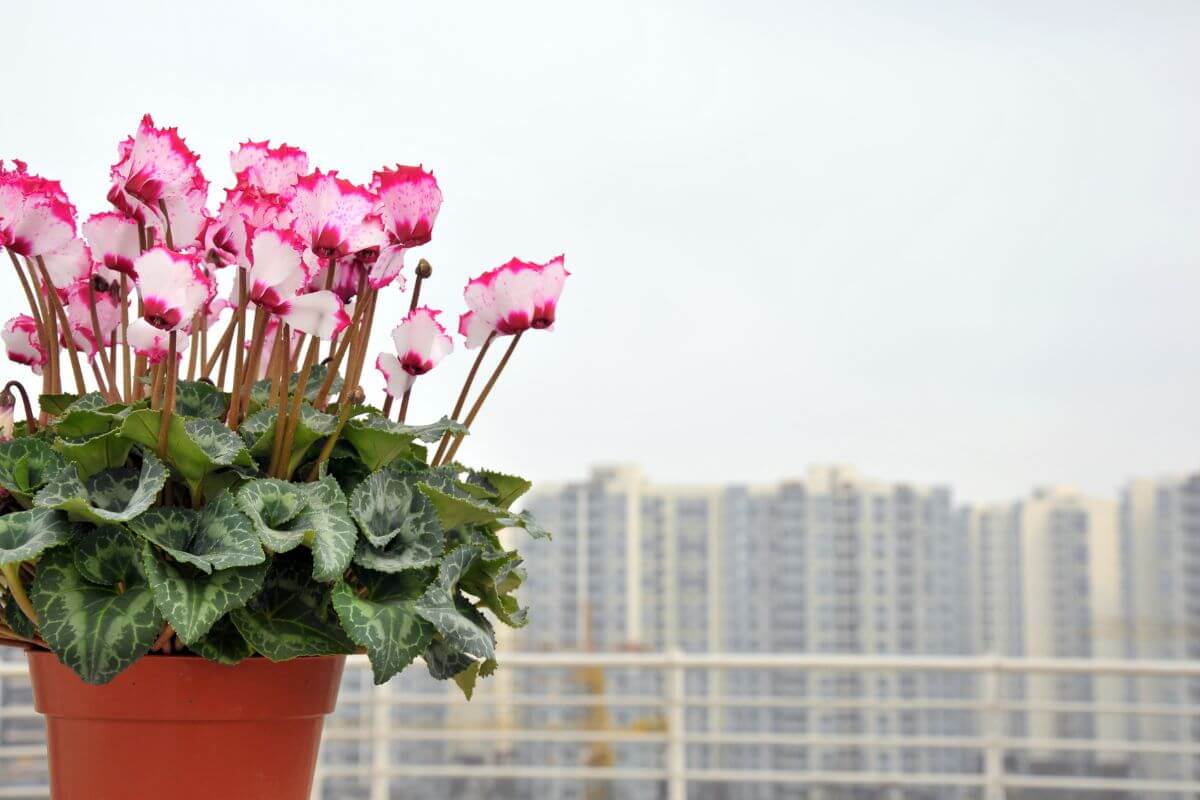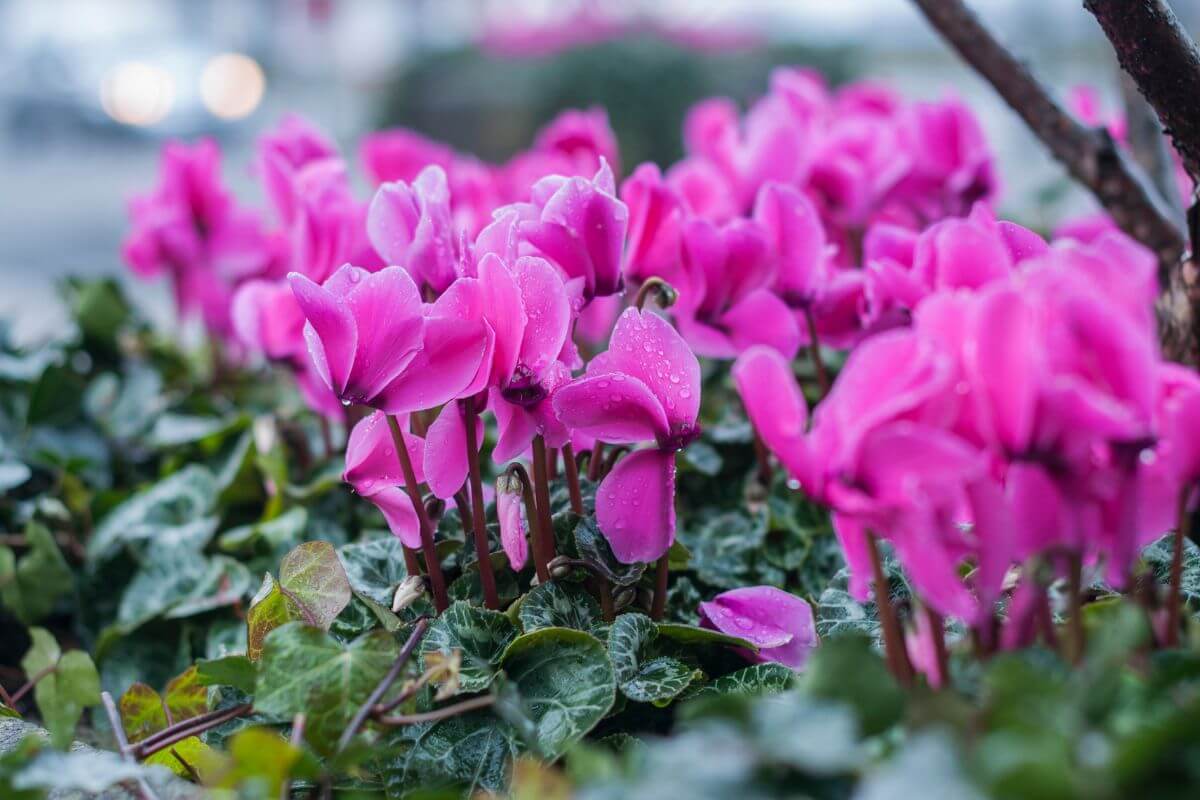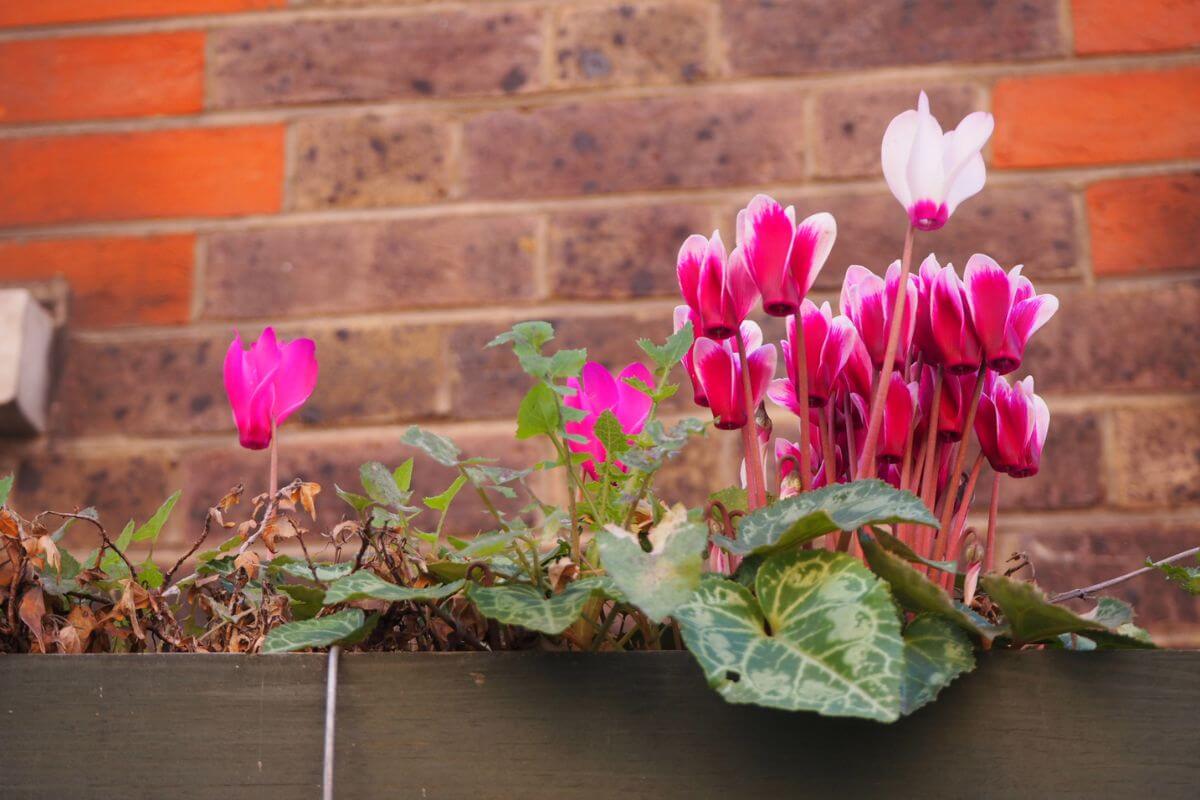Cyclamen plants are beautiful flowers that are native to the Mediterranean. They are also known as “winter cyclamens” because they bloom during winter months.
Cyclamen plants have been used for centuries as an ornamental plant. Today, cyclamen plants are grown commercially for their beautiful blooms.
This cyclamen care and growing guide will teach you how to grow cyclamen plants successfully.
Cyclamen Plant Overview

The cyclamen, aka the the cyclamen persicum, is a member of the Primulaceae family. It’s a flowering plant that is grown as a houseplant, but can thrive outdoors in the right conditions.
Popular during the holidays, many a Christmas gift will be a beautifully potted cyclamen. It is a perennial that is known as tuberous as it dies down to fleshy thick roots, called tubers, during its dormancy period which takes place in the summer. It regenerates in the fall as it awakens.
The cyclamen will bloom in varying shades of white, pink, red, and purple. Medium-sized, green-tinted leaves are shaped like hearts usually with silver-tinted marbling.
Often sold in nurseries, garden centers, supermarkets, and at florists, they can be grown from seeds by passionate gardeners.
There are quite a few varieties of cyclamen available for purchase. Their blooming period is relatively lengthy, so you will most probably see the color of bloom that you are selecting. Some of the more attractive varieties include:
- “Blanc Pur” known for its attractive snow white flowers.
- “Verano Red” offers crimson red flowers on long straight stems.
- “Scentsation” Cyclamen is found with pink or red blooms and a strong appealing fragrance.
- “Sierra” Cyclamen featuring large flowers measuring from two to eight inches in a multitude of colors that include lilac, pink, purple, salmon, scarlet red, and white.
- “Victoria” Cyclamen offers white flowers that feature red accents.
- “Violette” produces bright magenta colored blooms.
- “Winfall White” is characterized by white flowers and marbled foliage.
Cyclamen Plant Care
Normally cultivated in pots, it is a winter bloom that goes dormant in the summer. If well cared for, it will regenerate and bloom once autumn rolls around.
When temperatures increase, the cyclamen will enter dormancy. If you have a cool environment, the plant may snooze, but won’t go dormant. It will most probably thin out and not bloom again until the fall.
To spur new blooming, spent flower stalks need to be cut off at their base. When flowering slows, it will enter its dormancy period and should be permitted to dry out for approximately three months.
If the roots receive too much water, it may lead to rotting. A sip of water is fine, but the soil bed should not stay wet during this period.
Soil for the Cyclamen
Your cyclamen will prefer a moist soil bed that is rich in organic material and well-draining. Soil bed pH should be slightly acidic in the range of 5.8.
If you are growing your cyclamen in a pot, a standard potting soil mix can be used with a bit of sphagnum peat blended in to increase the acidity.
Light for the Cyclamen
Cyclamens love bright, but indirect light especially during the winter months as this is the plant’s growing period.
During the summer months, cyclamens should be kept in darker locations that are cooler and air that circulates.
Water and Humidity for the Cyclamen

If leaves are present on your plant, it is growing. The plant should be watered whenever the soil bed is dry to about an inch under the surface. When the plant loses most if not all of its leaves, water it occasionally to prevent the soil bed from drying out completely.
When watering the plant, try not to wet the leaves or the crown because this can contribute to rotting. Water on the leaves can lead to mildew. Standing your plant in a saucer filled with water for an hour or so is a great alternative to watering from above.
Cyclamens need high humidity during the winter growing period. You can guarantee this with a humidifier for plants, or a pebble and water tray.
Fill the tray with pebbles and then water. Place the pot on the tray and pebbles, but keep it above the water to avoid root rot. Another option to add humidity to the air is placing a bowl filled with water near the plant.
Temperature for the Cyclamen
Even though cyclamens are native to the Mediterranean, they do not like heat or dry air. They prefer temperatures that are in the 60° to 70° Fahrenheit range during the daytime, and between 40° and 50° F in the evening. Be sure to avoid frosts.
Ideally, a cyclamen cultivated indoors needs a bright, cool location. Direct sunlight should be avoided. If the indoor temperature is too hot, leaves will turn yellow and your plant will enter dormancy.
If you transfer your potted cyclamen outdoors for the summer, make sure to bring it into the house before the temperatures drop and the cold arrives. They should be moved indoors while you are still able to open the windows weather-wise.
Fertilization for the Cyclamen
Cyclamens need to be fed biweekly during the growing season when they are in full leaf. It is not necessary to fertilize during summer dormancy.
A liquid fertilizer that is low in nitrogen and diluted is ideal.
Pruning and Repotting the Cyclamen

Cyclamens do not require pruning, but spent blooms or leaves can be snipped at the base of the stems.
Cyclamen plants should be repotted every other year during its dormant period. When repotting your cyclamen, the new pot should allow for an inch of space around the plant’s tuber. Position the tuber so that it protrudes a bit out of the soil bed.
To repot, simply remove the tuber from its old container, remove old soil, and place it in the new pot with new soil. The top of the plant should sit approximately two inches from the rim of the container. Cover it completely with the potting soil mix and put it in a shady spot.
In the fall, at the beginning of September, begin watering it. Shortly after that, you should start seeing new growth.
Propagating the Cyclamen
Cyclamens can be propagated with seeds, but they take quite a while to germinate. Seeds need to be soaked in water for 24 hours, and then placed in a soil bed.
For outdoor seeding, semination should take place in the spring. The soil should measure between 45° and 55°F. The plants will bloom the following year.
They can also be propagated through plant division. Leaves and stem cuttings will not work. Instead, you will want to use the underground swollen tuber root. In the fall, you can lift the tuber from the soil bed and divide it.
Plant the pieces under approximately two inches of soil. You will want them to root before the winter season arrives. You can add a layer of mulch to protect the tuber from colder weather if you are planting your cyclamens outdoors.
Cyclamen Toxicity and Pets
Unfortunately, the cyclamen is toxic to both humans and pets. This includes cats, dogs, and horses.
You’ll want to keep the plants away from domestic pets, as well as out of reach of children. Poisoning symptoms will include:
- Diarrhea
- Drooling
- Loss of appetite
- Vomiting
Severe poisoning may cause an abnormal heart rate or seizures, and may lead to death. If you see your pet or child ingest cyclamen, or if you suspect ingestion, contact your local poison control center, your doctor, or your veterinarian immediately.
Cyclamen Pests, Diseases, Problems, and More

Typical problems when cultivating a cyclamen include:
- Collapsed Cyclamen – This may be due to overwatering. If it is mushy and brown colored at the center, it may be suffering from root rot or crown rot from water reaching the stems and leaves. Collapsing may also be a result of temperatures being too low, or vine weevil larvae that may be attacking the plant’s roots.
- Yellow Leaves – In the fall or winter seasons, yellow indicates that the temperature is too warm. They also may indicate overwatering or underwatering. The Cyclamen should be in a bright room, but out of direct sunlight. It needs to be watered when the soil is dry. In the spring, yellow leaves will be normal because your cyclamen is going into the summer dormancy period.
- Gray Mold – A fuzzy gray mold on the flowers or the plant’s stems may indicate the gray mold Botrytis cinerea. This is common in humid conditions. By removing spent flowers and dead leaves promptly, you can help the plant to avoid this disease. Also avoiding splashing water on the leaves for prevention.
- Poor Blooming – This is normally due to the environment being too warm which sends the plant into early dormancy.
- Pests – Cyclamen pests include the cyclamen mite, aphids, leaf miner, spider mites, thrips, and vine weevils among others.
Cyclamen Plant Final Thoughts
Cyclamen plants are showy winter plants renowned for their spectacular blooms in bright appealing colors. Flowers may be scented or a bit frilly, and find the perfect frame in their heart-shaped, marbled green leaves.
With proper care, they can bloom for at least six weeks, brightening up homes and offices. They are a beautiful addition to outdoor gardens with the right climate, due to the fact that their roots do not invade or disturb other plants and shrubs.
Giving or receiving a cyclamen plant during the holidays is a time-honored tradition that both those who give and those who receive enjoy. The cyclamen is an enduring alternative to a bouquet of flowers that eventually will need to be tossed.
Here are other indoor plant guides that you should consider growing:
- Croton Plant Care and Grow Guide
- Areca Palm Care and Grow Guide
- African Violet Care and Grow Guide
- Dieffenbachia (Dumb Cane) Care and Grow Guide
Cyclamen Plant FAQs
Do cyclamen like sun or shade?
Cyclamen plants prefer bright, indirect sunlight. Give them partial shade to avoid direct sunlight, but be sure to give them lots of light.
Is a cyclamen an indoor or outdoor plant?
A cyclamen can be grown indoors and outdoors depending on the climate. They prefer 60° to 70°F temperatures, so keep them in a cool location with bright sunlight, but not direct. They do better in moist air.
Do cyclamen come back every year?
Yes! The cyclamen will come back each year with proper care. You just have to wait until next autumn when it comes out of its dormancy period.
How long do cyclamen plants last?
Cyclamen plants can last for decades if cared for properly, even 100 years! Give it organically rich, well-draining soil and water them regularly.
How do you care for a cyclamen plant?
The best way to grow a healthy cyclamen is by giving it plenty of light and regular watering. Provide plenty of moisture and keep the soil evenly moist throughout the growing season. Avoid overwatering by checking the top inch of soil frequently. Remove any wilted foliage immediately, while keeping the leaves dry.


